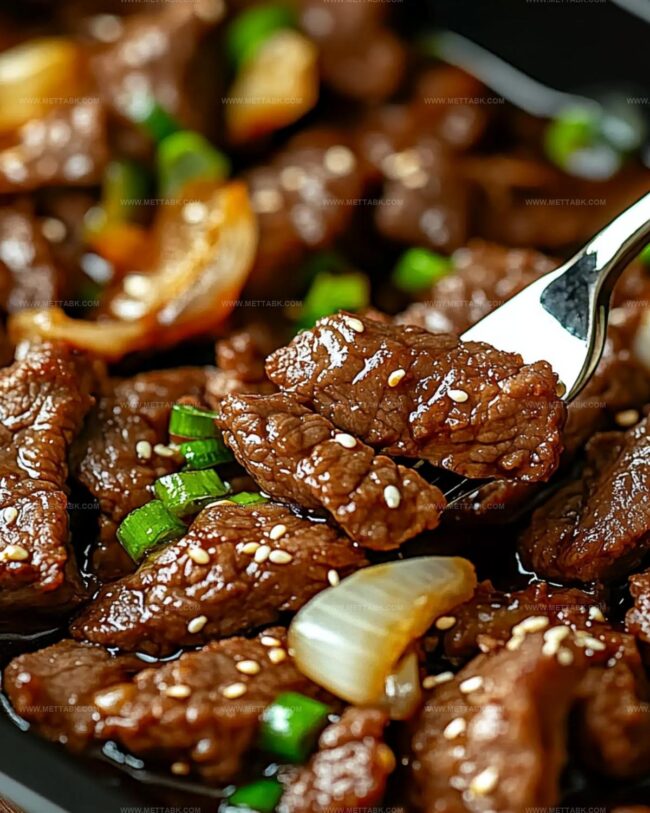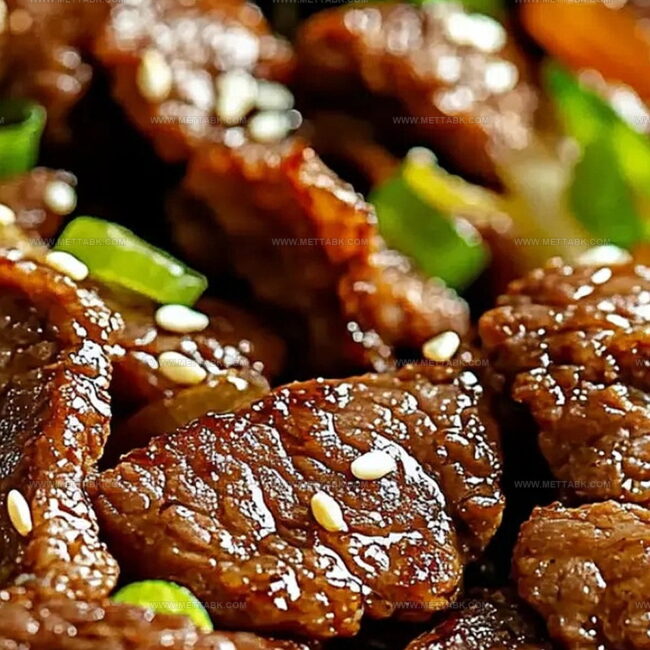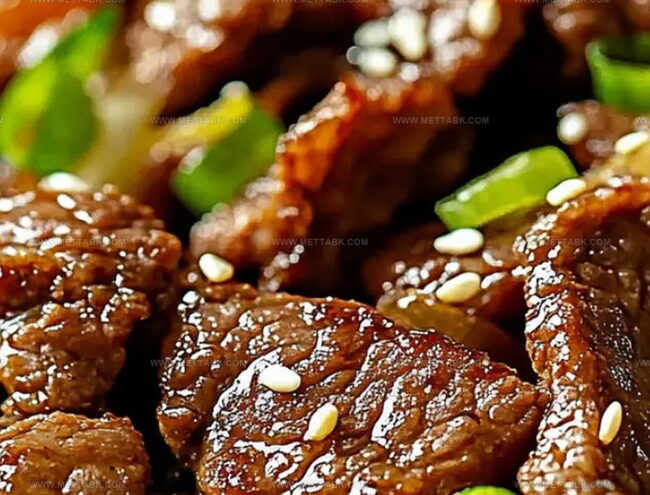Sizzling Sheet Pan Korean Beef Bulgogi Recipe for Weeknights
Mouthwatering korean beef bulgogi sparks memories of sizzling street food in seoul’s bustling markets.
Savory marinated strips promise an explosion of flavor that dances across your palate.
Tender meat caramelizes beautifully under high heat, creating irresistible crispy edges.
Weeknight dinners demand simple yet spectacular solutions that impress without complicated techniques.
Minimal ingredients and one pan make this recipe a champion for busy home cooks.
Quick marinades infuse deep, complex tastes that transport you instantly to korea’s vibrant culinary landscape.
Let’s unlock this delicious adventure that guarantees smiles around the dinner table.
Sheet Pan Korean Beef Bulgogi
Ingredients Needed for Sheet Pan Korean Beef Bulgogi
For the Protein:For the Marinade Components:For the Vegetables and Seasonings:For the Serving Suggestion:How to Make Sheet Pan Korean Beef Bulgogi
Step 1: Create Flavor-Packed Marinade
Whisk together a mouthwatering blend of ingredients to infuse the beef with incredible taste:Add sliced beef to the marinade, ensuring every piece gets coated. Let the beef soak up the delicious flavors in the refrigerator for at least 1 hour.
Step 2: Prepare Baking Sheet Setup
Crank up your oven to a blazing 450°F (230°C). Grab a large baking sheet and toss:Drain the marinated beef and spread it out in a single layer next to the veggies.
Step 3: Roast to Delicious Perfection
Pop the baking sheet into the hot oven and roast for 10 minutes. You’re looking for beef with a slight char and vegetables that are perfectly tender.
Step 4: Finish and Feast
Sprinkle freshly sliced scallions over the top. Serve piping hot alongside steamed white rice for a meal that’ll make taste buds dance.
Tips That Help Sheet Pan Korean Beef Bulgogi
Variations to Try on Korean Beef Bulgogi
Suggested Pairings With Korean Beef Bulgogi
Proper Storage for Korean Beef Bulgogi
Store leftovers in an airtight container for up to 3-4 days. Cool the dish completely before sealing to prevent moisture buildup.
Transfer bulgogi to freezer-safe containers, removing excess air. Freeze for 2-3 months. Label with date and contents.
Place portions on a microwave-safe plate. Cover with a damp paper towel to retain moisture. Heat in 30-second intervals, stirring between each, until warmed through.
Warm beef in a skillet over medium heat. Add a splash of soy sauce or water to prevent drying. Stir gently until heated evenly, about 3-4 minutes.
FAQs
Gochujang adds authentic Korean flavor and heat, but if unavailable, you can substitute with sriracha or red pepper flakes for similar spiciness.
Sirloin or flank steak work best, as they’re tender and absorb marinade well. Avoid tough cuts like chuck that require longer cooking.
Replace regular soy sauce with tamari or gluten-free soy sauce. Ensure all other ingredients are certified gluten-free.
Partially freeze the beef for 15-20 minutes before slicing. This helps you cut very thin, even slices against the grain for maximum tenderness.
Print
Sheet Pan Korean Beef Bulgogi Recipe
- Total Time: 25 minutes
- Yield: 4 1x
Description
Sizzling sheet pan Korean beef bulgogi delivers bold flavors straight from Seoul’s culinary landscape. Succulent marinated beef caramelizes perfectly, creating a quick and delicious meal you can enjoy with minimal cleanup and maximum satisfaction.
Ingredients
Proteins:
- 1.5 pounds (680 grams) beef sirloin, sliced thin
Vegetables:
- 1 medium onion, sliced
- 8 ounces (227 grams) snap peas, trimmed
- 3 scallions, sliced
Sauces and Seasonings:
- 1/4 cup soy sauce
- 2 tablespoons brown sugar
- 1 tablespoon Worcestershire sauce
- 1 tablespoon minced ginger
- 2 cloves garlic, minced
- 1 tablespoon gochujang (or chili garlic sauce)
- 1 tablespoon sesame oil
- 2 tablespoons olive oil
- Salt and pepper, to taste
Serving:
- Steamed white rice
Instructions
- Create a robust marinade by blending soy sauce, brown sugar, Worcestershire sauce, minced ginger, crushed garlic, gochujang, and sesame oil in a mixing container.
- Immerse sliced beef thoroughly in the marinade, ensuring complete coverage. Refrigerate for minimum 1 hour to enhance flavor penetration.
- Heat oven to 450F (230C), preparing a spacious sheet pan for roasting.
- Scatter onions and snap peas across one section of the pan, drizzling with olive oil and seasoning with salt and pepper.
- Remove beef from marinade, carefully arranging pieces in a single layer on the remaining pan space to ensure even cooking.
- Roast for approximately 10 minutes, watching for beef to develop slight char and vegetables to become tender and caramelized.
- Remove from oven and garnish with freshly sliced scallions for added brightness and aromatic complexity.
- Serve immediately atop steamed white rice, allowing the meat’s rich marinade to infuse the grains with intense Korean-inspired flavors.
Notes
- Boost marinade depth by adding a splash of rice wine or mirin for extra umami flavor complexity.
- Slice beef against the grain super thin to ensure maximum tenderness and quicker cooking.
- For gluten-free version, swap regular soy sauce with tamari and use gluten-free Worcestershire sauce alternative.
- Customize heat levels by adjusting gochujang quantity or using mild chili paste for sensitive palates.
- Prep Time: 15 minutes
- Cook Time: 10 minutes
- Category: Lunch, Dinner
- Method: Roasting
- Cuisine: Korean
Nutrition
- Serving Size: 4
- Calories: 350 kcal
- Sugar: 6 g
- Sodium: 700 mg
- Fat: 18 g
- Saturated Fat: 5 g
- Unsaturated Fat: 12 g
- Trans Fat: 0 g
- Carbohydrates: 15 g
- Fiber: 2 g
- Protein: 30 g
- Cholesterol: 70 mg





Nate Harper
Founder & Recipe Curator
Expertise
Single-Recipe Development, Farm-to-Table Cooking, Seasonal Menu Planning, Culinary Storytelling, Home Kitchen Innovation
Education
Cascade Culinary Institute – Central Oregon Community College
Certificate in Culinary Arts
Focus: Farm-to-table cuisine, sustainable cooking practices, and seasonal recipe creation.
Nate studied under experienced chefs who emphasized local sourcing, minimal waste, and building recipes from fresh, simple ingredients.
Nate Harper is the founder and creative force behind Make, Take, Bake. Raised in the wild beauty of Oregon’s high desert, Nate grew up surrounded by family gardens, farmers’ markets, and home kitchens that celebrated the seasons.
His early love for simple, honest food evolved into a professional passion when he attended Cascade Culinary Institute, where he sharpened his skills in creating recipes that are sustainable, satisfying, and made for everyday life.
Nate’s goal is to make cooking feel accessible, free of fuss, and full of flavor. He believes a single, thoughtfully built dish can stand alone, and sometimes even steal the show.